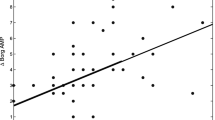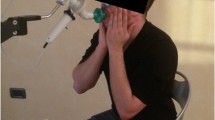Abstract
Dyspnea has a multifactorial nature and the exact mechanism that causes breathlessness in asthma is not fully understood. There is compelling evidence that factors other than merely mechanical ones take part in the pathophysiology of breathlessness. Some recent reports attribute airway inflammation, which may contribute to the unexplained variability in the perception of dyspnea associated with bronchoconstriction. Eosinophil airway inflammation has been proposed as a determinant of breathlessness via mechanisms affecting either the mechanical pathways that control breathlessness or the afferent nerves involved in perception of dyspnea. In this review, data on the interrelation between inflammation and dyspnea sensation and the impact of treatment on dyspnea sensation are discussed. We conclude that regardless of whether mechanical or chemical inflammatory factors are involved, much variability in dyspnea scores remains unexplained.


Similar content being viewed by others
References
Banzett RB, Dempsey JA, O’Donnell DE, Wamboldt MZ (2000) Symptom perception and respiratory sensation in asthma. Am J Respir Crit Care Med 162:1178–1182
Barnes PJ (1992) Poorly perceived asthma. Thorax 47:408–409
Bijl-Hofland ID, Cloosterman SG, Folgering HT, Akkermans RP, van Schayck CP (1999) Relation of the perception of airway obstruction to the severity of asthma. Thorax 54:15–19
Bijl-Hofland ID, Cloosterman SG, Folgering HT, et al. (2001) Inhaled corticosteroids, combined with long-acting beta(2)-agonists, improve the perception of bronchoconstriction in asthma. Am J Respir Crit Care Med 164:764–769
Bjorck T, Gustafsson L, Dahlen S (1992) Isolated bronchi from asthmatics are hyperresponsive to adenosine, which apparently acts indirectly by liberation of leukotrienes and histamine. Am Rev Respir Dis 145:1087–1092
Boulet LP, Turcotte H, Cartier A, et al. (1998) Influence of beclomethasone and salmeterol on the perception of methacholine-induced bronchoconstriction. Chest 114:373–379
Bousquet J, Chanez P, Vignola AM, Lacoste JY, Michel FB (1994) Eosinophil inflammation in asthma. Am J Respir Crit Care Med 150(5 Pt 2):S33–S38
Bradley BL, Azzawy M, Jacobson M, et al. (1991) Eosinophils, T-lymphocytes, mast cells, neutrophils, and macrophages in bronchial biopsy specimens from atopic subjects with asthma: comparison with biopsy specimens from atopic subjects without asthma and normal control subjects and relationship to bronchial hyperresponsiveness. J Allergy Clin Immunol 88:661–674
Burdon JG, Juniper EF, Killian KJ, Hargreave FE, Campbell EJ (1982) The perception of breathlessness in asthma. Am Rev Respir Dis 126:825–828
Burki NK, Dale WJ, Lee L-Y (2005) Intravenous adenosine and dyspnea in humans. J Appl Physiol 98:180–185
Chetta A, Gerra G, Foresi A, et al. (1998) Personality profile and breathlessness perception in outpatients with different gradings of asthma. Am J Respir Crit Care Med 157:116–122
Coleridge JC, Coleridge HM (1984) Afferent vagal C fibre innervation of the lungs and airways and its functional significance. Rev Physiol Biochem Pharmacol 99:1–110
Coleridge HM, Coleridge JCG (1986) Reflex evoked from tracheo-bronchial tree and lungs. In: Cherniack NS, Widdicombe JG (eds) Handbook of physiology. Section 3: Respiratory system, vol II, part 1: Control of breathing. American Physiological Society, Bethesda, MD, pp 395–429
Coleridge HM, Coleridge JCG, Ginzel KH, et al. (1976) Stimulation of ‘irritant’ receptors and afferent C-fibers in the lungs by prostaglandins. Nature 264:451–453
Corrigan CJ, Kay AB (1991) The roles of inflammatory cells in the pathogenesis of asthma and of chronic obstructive pulmonary disease. Am Rev Respir Dis 143:1165–1168
Dahl R, Venge P, Fedens K (1988) The Eosinophil. In Barnes P, Rodger IW, Thomson NC (eds) Asthma: Basic mechanisms and clinical management. Academic Press Limited, San Diego, CA, pp 395–429
De Monchy JG, Kauffman HF, Venge P, et al. (1985) Bronchoalveolar eosinophilia during allergen induce late asthmatic reactions. Am Rev Respir Dis 131:373–376
Djukanovic R, Roche WR, Wilson JW, et al. (1990) Mucosal inflammation in asthma. State of the art. Am Rev Respir Dis 142:434–457
Fahy JV, Boushey HA (1998) Effect of low-dose beclomethasone dipropionate on asthma control and airway inflammation. Eur Respir J 11:1240–1247
Fessler HE, Brower RG, Permutt S (1995) CPAP reduces inspiratory work more than dyspnea during hyperinflation with intrinsic PEEP. Chest 108:432–440
Fox AJ, Barnes PJ, Urban L, Dray A (1993) An in vitro study of the properties of single vagal afferents innervating guinea-pig airways. J Physiol 469:21–35
Higgs CMB, Laszlo G (1996) Influence of treatment with beclomethasone, cromoglycate and theophylline on perception of bronchoconstriction in patients with bronchial asthma. Clin Sci 90:227–234
Ho CY, Gu Q, Hong JL, Lee LY (2000) Prostaglandin E(2) enhances chemical and mechanical sensitivities of pulmonary C fibers in the rat. Am J Respir Crit Care Med 162(2 Pt 1):528–533
Holgate ST, Church MK, Polosa R (1991) Adenosine: a positive modulator of airway inflammation in asthma. Ann NY Acad Sci 629:227–236
Holtzman MJ (1991) Sources of inflammatory mediators in the lung: the role of epithelial and leukocyte pathways for arachidonic acid oxygenation. In: Bray MA, Anderson WH (eds) Mediators of pulmonary inflation: lung biology in health and disease series, vol 54. Dekker, New York, pp 279–326
Holtzman MJ, Zhang V, Hussain H, Roswit WT, Wilson JD (1994) Prostaglandin H synthase and lipoxygenase gene families in the epithelial cell barrier. Ann N Y Acad Sci 744:58–77
Hudgel DW, Cooperson DM, Kinsman RA (1982) Recognition of added resistive loads in asthma: the importance of behavioral styles. Am Rev Respir Dis 126:121–125
Ingenito EP, Godleski JJ, Pliss LB, Pichurko BM, Ingram RH Jr (1992) Relationship among mediators, inflammation, and volume history with antigen versus hyperpnea challenge in guinea pig. Am Rev Respir Dis 146(5 Pt 1):1315–1319
Kaufman MP, Coleridge HM, Coleridge JC, Baker DG (1980) Bradykinin stimulates afferent vagal C fibers in intrapulmonary airways of dogs. J Appl Physiol 48:511–517
Killian KJ, Jones NL (1988) Respiratory muscles and dyspnea. Clin Chest Med 9:237–248
Lee LY, Morton RF (1995) Pulmonary chemoreflex sensitivity is potentiated by prostaglandin E2 in anesthetized rat. J Appl Physiol 79:1679–1686
Lougheed MD, Lam M, Forkert L, Webb KA, O’Donnel DE (1993) Breathlessness during acute bronchoconstriction in asthma: Pathophysiologic mechanisms. Am Rev Respir Dis 148:1452–1459
Makker HK, Holgate ST (1993) The contribution of neurogenic reflexes to hypertonic saline-induced bronchoconstriction in asthma. J Allergy Clin Immunol 92:82–88
Manning HI, Schwartzstein RM (1995) Pathophysiology of dyspnea. N Engl J Med 333:1547–1553
Marks GB, Yates DH, Sist M, et al. (1996) Respiratory sensation during bronchial challenge testing with methacholine, sodium metabisulphite, and adenosine monophosphate. Thorax 51:793–798
Miura M, Belvisi MG, Barnes PJ (1992) Effect of bradykinin on airway neural responses in vitro. J Appl Physiol 73:1537–1541
Moy ML, Lantin ML, Harver A, Schwartzstein RM (1998) Language of dyspnea in assessment of patients with acute asthma treated with nebulized albuterol. Am J Respir Crit Care Med 158:749–753
Moy ML, Woodrow Weiss J, Sparrow D, Israel E, Schwartzstein RM (2000) Quality of dyspnea in bronchoconstriction differs from external resistive loads. Am J Respir Crit Care Med 162:451–455
Nichol G, Nix A, Chung KF, Barnes PJ (1989) Characterisation of bronchoconstrictor responses to sodium metabisulphite aerosol in atopic subjects with and without asthma. Thorax 44:1009–1014
Noseda A, De Bruyne I, De Maertelaer V, Yernault JC (2000) Does an IV bolus of methylprednisolone relieve dyspnea in asthma exacerbations? Chest 118:1530–1537
Ollerenshaw SL, Woolcock AJ (1992) Characteristics of the inflammation in biopsies from large airways of subjects with asthma and subjects with chronic airway limitation. Am Rev Respir Dis 145:922–927
Ottanelli R, Rosi E, Romagnoli I, et al. (2000) Perception of bronchoconstriction and bronchial hyperresponsiveness in asthma. Clin Sci 98:681–687
Ottanelli R, Rosi E, Romagnoli I, et al. (2001) Do inhaled corticosteroids affect perception of dyspnea during bronchoconstriction in asthma? Chest 120:770–777
Paintal AS (1973) Vagal sensory receptors and their reflex effects. Physiol Rev 53:159–227
Pauwels R, Joos G, van der Straeten M (1988) Bronchial hyperresponsiveness is not bronchial asthma. Clin Allergy 18:317–321
Peiffer C, Toumi M, Razzouk H, Marsac J, Lockhart A (1992) Relationship between spontaneous dyspnoea and lability of airway obstruction in asthma. Clin Sci 82:717–724
Pizzichini MM, Pizzichini E, Clelland L, et al. (1997) Sputum in severe exacerbation of asthma. Kinetics of inflammatory indices after prednisone treatment. Am J Respir Crit Care Med 155:1501–1508
Pliss LB, Ingenito EP, Ingram RH (1989) Responsiveness, inflammation and effects of deep breaths on obstruction in mild asthma. J Appl Physiol 66:2298–2304
Polosa R, Holgate S, Cjurch M (1989) Adenosine as a pro-inflammatory mediator in asthma. Pulmon Pharmacol 2:21–26
Rafferty P, Beasley R, Holgate S (1987) The contribution of histamine to immediate bronchoconstriction provoked by inhaled allergen and adenosine 5′ mopnophosphate in atopic asthma. Am Rev Respir Dis 136:369–373
Rietveld S (1998) Symptom perception in asthma: a multidisciplinary review. J Asthma 35:137–146
Roisman GL, Peiffer C, Lacronique JG, Le Cac A, Dusser DJ (1995) Perception of bronchial obstruction in asthmatic patients. Relationship with bronchial eosinophilic inflammation and epithelial damage and effect of corticosteroid treatment. J Clin Invest 96:12–21
Rosi E, Lanini B, Ronchi MC, et al. (2002) Dyspnea, respiratory function and sputum profile in asthmatic patients during exacerbations. Respir Med 96:745–750
Rubinfeld AR, Pain MCF (1977) Conscious perception of bronchospasm as a protective phenomenon in asthma. Chest 72:154–158
Salome CM, Reddel HK, Ware SI (2002) Effect of budesonide on the perception of induced airway narrowing in subjects with asthma. Am J Respir Crit Care Med 165:15–21
Salome CM, Leuppi JD, Freed R, Marks GB (2003) Perception of airway narrowing during reduction of inhaled corticosteroids and asthma exacerbation. Thorax 58:1042–1047
Simon PM, Schwartzstein RM, Weiss JW, et al. (1990) Distinguishable types of dyspnea in patients with shortness of breath. Am Rev Respir Dis 142:1009–1014
Sont JK, Booms P, Bel EH, Vandenbroucke JP, Sterk PJ (1995) The severity of breathlessness during challenges with inhaled methacholine and hypertonic saline in atopic asthmatic subjects. Am J Respir Crit Care Med 152:38–44
Taguchi O, Kikuchi Y, Hida W, et al. (1992) Prostaglandin E2 inhalation increases the sensation of dyspnea during exercise. Am Rev Respir Dis 145:1346–1349
Taguchi O, Kikuchi Y, Hida W, et al. (1991) Effects of bronchoconstriction and external resistive loading on the sensation of dyspnea. J Appl Physiol 71:2183–2190
Teeter JG, Bleecker ER (1998) Relationship between airway obstruction and respiratory symptoms in adult asthmatics. Chest 113:272–277
Umeno E, McDonald D, Nadel J (1990) Hypertonic saline increases vascular permeability in the trachea by producing neurogenic inflammation. J Clin Invest 85:1905–1908
van den Toorn LM, Overbeek SE, Prins JB, Hoogsteden HC, De Jongste JC (2002) Dyspnoea perception during clinical remission of atopic asthma. Eur Respir J 19:1047–1050
van den Toorn LM, Overbeek SE, De Jongste JC, Leman K, Hoogsteden HC, Prins JB (2001) Airways inflammation is present during clinical remission of atopic asthma. Am J Respir Crit Care Med 164:2107–2113
Veen JC, Smits HH, Ravensberg AJ, et al. (1998) Impaired perception of dyspnea in patients with severe asthma Relation to sputum eosinophils. Am J Respir Crit Care Med 158:1134–1141
Wardlaw AJ, Dunnette S, Gleich GJ, Collins JV, Kay AB (1988) Eosinophils and mast cells in bronchoalveolar lavage in subjects with mild asthma relationship with bronchial hyperreactivity. Am Rev Respir Dis 137:62–69
Wilson RC, Jones PW (1991) Differentiation between the intensity of breathlessness and the distress it evokes in normal subjects during exercise. Cli Sci 80:65–70
Yan S (1999) Sensation of inspiratory difficulty during inspiratory threshold and hyperinflationary loadings. Effect of inspiratory muscle strength. Am J Respir Crit Care Med 160:1544–1549
Author information
Authors and Affiliations
Corresponding author
Rights and permissions
About this article
Cite this article
Rosi, E., Stendardi, L., Binazzi, B. et al. Perception of Airway Obstruction and Airway Inflammation in Asthma: A Review. Lung 184, 251–258 (2006). https://doi.org/10.1007/s00408-005-2590-z
Accepted:
Issue Date:
DOI: https://doi.org/10.1007/s00408-005-2590-z




